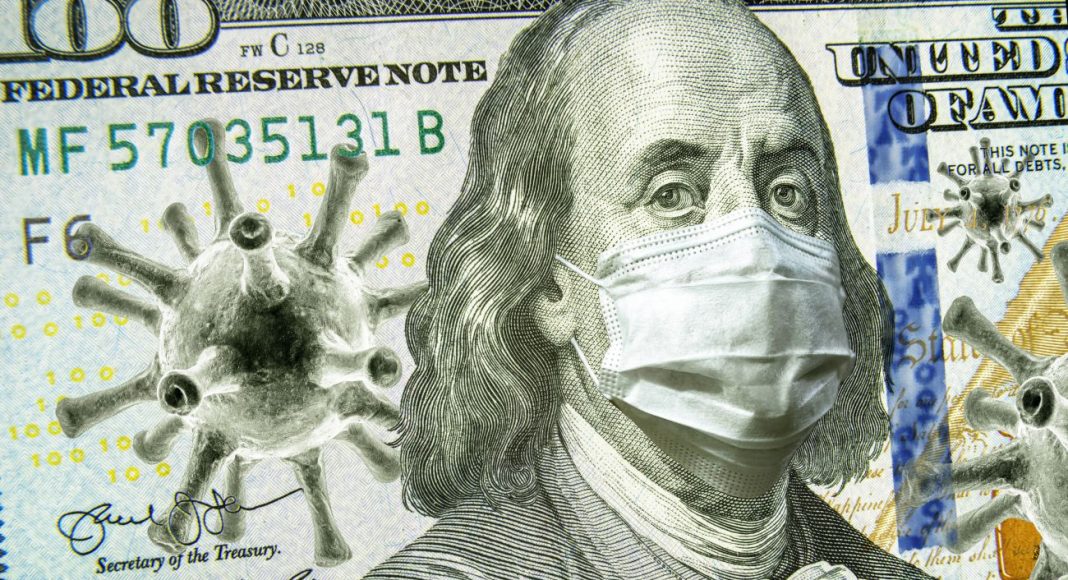As the Covid-19 crisis evolves from a temporary shock into what seems like a long-term catastrophe, six finance scholars from Chicago Booth—Douglas Diamond, Steven Kaplan, Anil Kashyap, Raghuram Rajan, Robert Vishny, and Luigi Zingales—discuss possible policy solutions.
When President Donald Trump signed the CARES Act on March 27, he explained that the purpose of the $2.2 trillion stimulus package was to “deliver urgently needed relief to our nation’s families, workers, and businesses. And that’s what this is all about.” At that moment, Congress’ and White House’s goal was to prevent a liquidity crisis, to freeze the economy, and flatten the coronavirus infection curve.
Three months later, what at the time looked like a temporary shock is rapidly evolving into a long-term catastrophe. Policymakers face an unprecedented challenge, as extraordinary initial measures already look inadequate. How should economic policy deal with the next phase of the Covid-19 crisis?
Six Booth finance scholars started a conversation (on Zoom) from very different perspectives, but eventually, they found common ground and advanced some proposals. The six scholars are Douglas Diamond, Steven Kaplan, Anil Kashyap, Raghuram Rajan, Robert Vishny, and Luigi Zingales. They have been colleagues for more than 25 years, and while they do not necessarily agree on the details of the policy response, they share the same sense of urgency.
According to Anil Kashyap, “The six of us agree that a recovery will take far longer than anybody thought in March, after the pandemic outbreak and the first social distancing and shelter-in-place measures.”
The six economists discussed many policy options. Each time some of them agreed on why something might work, another member of the group found an argument to explain why that intervention could fail or even backfire. However, their conversation offers an insight into what the policy debate’s top priority will be in a few weeks.
They shared their thoughts with ProMarket.
Support programs currently in place were set up in March with the idea that American companies simply needed bridge loans to survive temporary trouble. Now we know that many firms will lose their revenues for months, maybe for more than a year. Many of them will need to be restructured. What is the best way to facilitate this process? Should governments accelerate the transition to a new equilibrium or slow it down in order to minimize negative social consequences?
According to Luigi Zingales, “The pandemic might accelerate structural changes that were already taking place.” Amazon was there even before the Covid-19, but with millions of Americans stuck at home, it has become the backbone of the American economy and a vital supplier of basically everything people needed during the lockdown. Restaurants that produce food only for take-away have always existed, but now their business model has dramatically increased its potential.

“The problem of policy intervention becomes much more difficult than simply fixing a temporary crisis. On the one hand, policymakers have an interest in accelerating the process of creative destruction and the transition to a new model. On the other hand, they have to minimize the impact that this transition will have in terms of social and economic damages,” Zingales argues.
In order to manage this creative destruction, policymakers should be able to distinguish between firms that are fit to survive and grow and others that are doomed. But in such an unprecedented situation, this distinction is complicated.
Based on their resilience to the Covid-19 crisis, Raghuram Rajan groups firms in three categories: “We call ‘Type 1’ companies those that still have a strong demand for their products; they didn’t accumulate too much debt and when the economy opens up, demand picks up and everything will be fine for them. ‘Type 2’ companies still face high demand for their products, but they have accumulated high debts and when the economy picks up again they might need to restructure their debt because it might prevent them from financing the working capital they need. And then we have ‘Type 3’ companies: as demand has changed for their products, such companies will find it hard to return to normalcy and are unlikely to remain viable.”

According to Rajan’s classification, “Type 1 firms do not need any help, but they will take it if it is given. Type 2 require either help or restructuring, but bankruptcy courts will get overcrowded, so maybe we should help these companies, not with additional debt but with equity. For Type 3 demand has evaporated, they should go out of business. But how do we distinguish between Type 2 and Type 3?”
When Congress approved the CARES Act at the end of March, the sense of urgency meant that this distinction was glossed over. “In designing the programs, there was not much thought about how we were going to decide in the future which firms to keep alive and which firms to let die. In the early stages of the crisis, policymakers were thinking that some of these companies will still be solvent after the Covid period because they would still have some equity beyond the amount of debt they had. But the government doesn’t know in advance which firms are going to be solvent,” Douglas Diamond observes.
If the crisis lasts for many months or even years, “the vast majority of these firms will be insolvent, in the sense that the present value of their future profits will be lower than the value of their existing debt,” Diamond argues. Therefore, bankruptcy courts will be key institutions to allocate losses and decide which companies should stay alive and which should be let go away, “but we should spend some more time thinking about how government programs can smooth the process through bankruptcy courts.” To prevent courts from getting overwhelmed, Diamond proposes that policymakers should “design incentives for private parties to find agreements outside courts.”

The technicalities are challenging even for such finance veterans as Diamond: “If the firm is going to stay alive, we would like the government to write down part of its claim even outside bankruptcy if other debt holders also write down their claims. If a bankruptcy court might liquidate the company and close it down, the government should have a relatively senior claim to minimize the cost to taxpayers. It is hard to design a claim that is sometimes junior inside or outside bankruptcy and sometimes senior, without the government making politically charged decisions.”
Rajan has an answer to Diamond’s problem: “It would be helpful if the government’s claims were convertible in equity. The government should have a reasonable return on the upside, but not so much such that it would discourage companies to ask for help. On the other hand, the government should not pay for all of the pre-existing creditors. My proposal is that the government has a super senior credit status. After a certain period, if the firms survive, it starts to convert its credit into equity but at a reasonable rate that doesn’t overvalue the existing equity.”

Steven Kaplan is very skeptical: “Is there a way to avoid the government being involved in equity?” Yes, Zingales answers: “The government already owns 21 percent of each firm—it is called taxation. When a firm needs help, the government can step in with super senior loans and some conditions attached to reduce some of the existing debt. When the situation improves, the firms will pay a higher rate of taxation.” If the alternative is bankruptcy, shareholders would be happy to accept even a higher rate of future taxation.
Different policies to address the same problems will have a very different impact on the companies’ employees. Should the government use taxpayer money to prevent layoffs or to increase unemployment benefits?
As Robert Vishny says, “the Federal Reserve has done a great job in keeping markets working and money flowing but the Fed needs some help from the fiscal side to bring back more of the 30 or 40 million jobs lost: simply lending to firms with no prospect of revenues hasn’t worked. Giving medium-sized companies forgivable loans hasn’t always worked either: firms don’t want to take a loan imposing the condition of keeping everybody employed because of the fear of going into deeper debt if maintaining employment becomes untenable.”
The Paycheck Protection Program (PPP) created by the CARES Act offered medium and small companies loans that may be forgiven if borrowers use the proceeds to maintain their payrolls and pay other specified expenses. Many firms returned the sums in order to be free to fire employees, and nearly 41 million Americans filed for unemployment claims since the crisis erupted. Should Congress replicate the PPP? Or perhaps a wait-and-see attitude creates less damage?

As Vishny explains, this is an eternal debate: “The strength of the European model is keeping people in the same job. On the opposite side, the US invests more in unemployment benefits under the premise that more benefits would provide support without forcing employer-employee matches to last forever.” When layoffs come, in order to find a new job usually people have to wait for long and painful months or look for some re-training.
“This is not always true: during the Coronavirus crisis, Amazon hired thousands of workers coming from sectors hit by the crisis, no specific training was needed,” Kaplan argues.
Rajan suggests exploiting our growing comfort with distance learning to train unemployed workers. “Now that we have learned to train at distance, is there any way to use these new skills? I suspect that colleges will stay largely closed for a year until we have a vaccine, and in the meantime, they face falling demand, especially from foreign students.” Therefore, they could rethink their mission and train unemployed American with very low marginal costs. “Raghu’s idea of using colleges to retrain people might be structured as a colleges’ bailout or, otherwise, in a different way. For example: If you hire a worker you don’t need yet, the government will pay some fraction of her salary and web learning classes,” Diamond suggests.
Workers are the first victims of the extended duration of the crisis. The second group of potential casualties are banks: insolvent firms always become, sooner or later, a banking problem. Since governments have already increased their deficits and debts to protect companies and taxpayers, they might be reluctant to save banks when the moment will come.
“Pretty soon, the banking sector will be hit by gigantic losses and non-performing loans. Should we worry about this and should we do something?” Zingales asks. One easy answer comes from the group: rules should not allow banks to use bailout funds to pay dividends.

Anil Kashyap adds that “we want to make sure that credit keeps on flowing, that new firms can have access to the money they need. We can discuss how much of the existing bank infrastructure we are going to use or if we want to have some form of good bank/bad bank approach, but we should keep an eye on where the growth will come from. And it doesn’t come from saving banks’ shareholders.”






